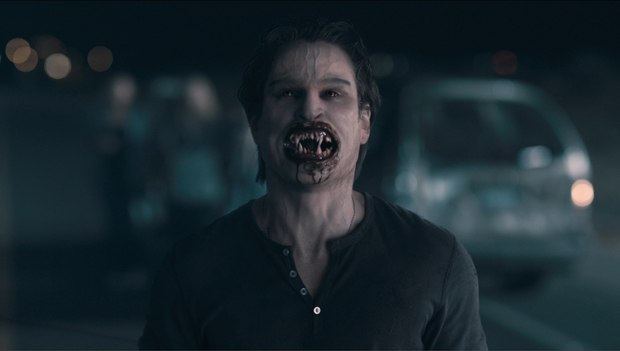Joe Bauer divulges the ghoulish VFX in this 3-D remake of a horror classic from the '80s.
Check out the Fright Night trailers and clips at AWNtv!
Fright Night is not only tailor made for 3-D, but is also ripe for the remake picking. Yes, even though Tom Holland's Fright Night from 1985 is a revered classic of camp and horror, Craig Gillespie (United States of Tara) has re-imagined it in a fun new post-modern way with the help of a witty script by Marni Noxon (Mad Men and Buffy the Vampire Slayer).
The film was shot using the 3-D rig by Paradise that incorporates two Red cameras. In fact, the longest shot (11 minutes), a highway attack, relied more on motion control than CG, though Pixel Magic and Shade replaced parts of the car with CG and added lots of compositing and color correction.
The trick was looking photographed until the wild climax, where the CG really kicks in. Luma Pictures did the bulk of the 400 or so shots, with lots of help from Pixel Magic, Digital Domain, Shade VFX, Eden FX, Entity VFX and Hammerhead.
Although Howard Berger's famed KNB FX group constructed an effective prosthetic vampire mouth, Luma augmented it with CG and even full CG work. "Craig had a very clear idea not only about how he wanted to use the teeth in their final position, but also how he wanted them to roll out," explains Joe Bauer, the production VFX supervisor. "He wanted it to be as disturbing to look at as possible and make you recoil. It ended up being quite an accomplished mouth rig for Amy [Imogen Poots], and we wound up using a variation of it for Jerry [Colin Farrell] when he transforms during the highway chase sequence. Otherwise, it's a pretty simple two-layer composite.
"But Luma created the stage four look for Jerry. It goes just fangs to the most bat-like extreme. Aside from the mouth and de-vamping shot, they had to move bones around under the skin and make it appear that he was fundamentally changing his form, which was pretty heavy CG lifting."
Meanwhile, Luma and Hammerhead (which did compositing) collaborated on the first dramatic surprise when a girl gets rescued but then explodes in sunlight. First there was a full-CG construction of the character followed by 50 layers of particle work as it passes through the sunbeams. "Craig wanted it to look like going through a meat grinder chain saw with a lot of ash particles thrown up in the air," Bauer continues. "It's a big 3-D moment. They worked a lot pulling the ambers into negative space. The trick for Luma was a shocking explosion but Craig wanted to see the anatomy and the skeleton as she's reduced to ash. At first, there were too many things flying close to camera. But the studio wanted to have objects flying into the lens, so they had to strike a balance so as not to obscure the evisceration of the character."
Speaking of 3-D, Steven Spielberg added a more dramatic shot when Jerry takes a bite out of an annoying teenager in the pool and he releases a cross. "We have a shot looking up in the cross part of the metal that is tumbling down through the water and toward camera," Bauer explains. That's an effective 3-D moment by Shade."
Spielberg also made an adjustment about Jerry's stage four look: "When he was all made up, he still wasn't as shocking as Steven would've liked," Bauer adds. "When they re-reviewed the original concept art, they noticed that the vampires had a shark-like mouth. They went as far as they could with prosthetics, so we took that back into a late CG build in the pipeline. For Luma, they post tracked more than a dozen shots and created a much uglier mouth for Jerry in which the jaw opens much wider and we look deep into his mouth."
But they saved the greatest amount of CG for last: Jerry's extended death sequence, which occurs in the basement of his house. Charley (Anton Yelchin) is on fire in a suit that he's made and attaches himself to Jerry and they're flying around, hitting the walls and ceiling, and ultimately it causes Jerry to go to stage five vampire, which is the only time we see that.
"There was never any practical makeup done for that so he becomes a full-CG character at that point," Bauer recalls. "So he actually gets attacked three ways: he's on fire, he gets staked and is also held in sunlight. There's some great anatomy close-up work with the stake going in the heart and then his particle-like destruction. It was a partnership between Luma and Digital Domain on some of the shots in that sequence, including the one where Jerry's vampire energy gets expelled. The energy gets released from the other vampires, swirls around the room, gets sucked into Jerry and then explodes. That frees everyone. That fire shot was created by Digital Domain. And they kept adding moments, raising the stakes, including the spirits done by Luma with Krakatoa, which provides an interesting dimensional effect in 3-D because it's very sculptural and holds odd shapes.
"We shot some practical fire elements that DD was able to use in generating the CG fire and other explosive particle elements. Fortunately, we got them right after Tron Legacy with their render and artist availability."
Bill Desowitz is former senior editor of AWN and editor of VFXWorld. He has a new blog, Immersed in Movies (www.billdesowitz.com), and is currently writing a book about the evolution of James Bond from Connery to Craig, scheduled for publication next year, which is the 50th anniversary of the franchise.










